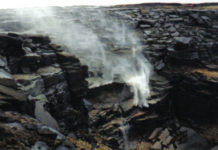A harmonious community situated somewhere in Asia, a dream world to fulfil all human aspirations: James Hilton’s Shangri-La captured the imagination of the Western world in the early 20th century. When the English novelist James Hilton chose to locate the action of his romantic adventure Lost Horizon in Shangri-La, he gave his native language a new word. The novel, published in 1933, and to an even greater extent the film made soon afterward, caught the public imagination. Shangri-La and the isolated utopian community it supported were presumed to be real.
Seemingly impassable mountains wreathed in mist hiding lush valleys are central to almost every legend of a perfect place removed from civilization, including Hilton’s Shangri-La in a part of the Far East where the landscape is dominated by high mountains sheltering fertile green valleys.
The community which Hilton’s two stranded airmen stumbled across was situated in a remote, unexplored and inaccessible region of Tibet. There, in a lamasery perched high on a mountain, 50 lamas (monks) spent their days in the pursuit of knowledge and the arts; at their head was the High Lama, who had discovered the secret of longevity and who also had the power to foretell the future. One of his prophesies was that Shangri-La would be threatened by barbarians from outside.
Guided by the principles of moderation in all things, the lamas ruled over 1000 Tibetans, who lived in peace and harmony in the fertile valley below. Here, in a stretch of land some 12 miles (20km) long and 5 miles (8km) wide, they grew a variety of crops. A rich gold seam meant that anything that could not be produced in Shangri-La could be bought from elsewhere. No strangers ever entered the city, however; villagers left the valley and met their contacts at prearranged points.
Precedents for Shangri-La are not difficult to find. There are many traditions of a hidden earthly paradise in Eastern cultures. Early Buddhist writings call it Chang Shambhala and describe it as a source of ancient wisdom. Belief in it was once widespread – in China, the Kunlun Mountains were believed to shelter a valley where immortals lived in perfect harmony while Indians sought a place called Kalapa, north of the Himalayas, said to be the home of ‘perfect men’. By following the path of the Tartars back to Mongolia, Russian legend held that one would reach Belovodye, where holy men lived apart from the world in the Land of White Waters. Tibetan and Mongolian legends, too, told of such a paradise.
Banners and tapestries illustrate Shambhala, ‘a place of peace and tranquility’ located in or to the north of Tibet, where high mountains encircle secret valleys.
If Shangri-La were to exist in reality rather than myth, then Tibet would be one of the most likely locations. The country could rightly be considered the most remote on Earth, once almost impossible to reach, and unwelcoming to foreigners. There, from his monastery-citadel at Lhasa (long a ‘forbidden city’ to Europeans), the Dalai Lama presided over the spiritual and material well-being of his subjects.
The very fact that so few Westerners had visited Lhasa fostered the belief that those who could visit the city would marvels. And certainly Buddhist monks and mystics were credited with extraordinary powers. One dramatic training was that of lung gom, which was reputed to allow adherents to overcome gravity and reduce their body weight so they could move along at fantastic speeds.
In 1924, the French traveler Alexandra David-Neel spent time in Lahsa disguised as a pilgrim. She recorded watching a lama travelling at an incredible speed without running: “he seemed to lift himself from the ground, proceeding by leaps. It looked as if he had been endowed with the elasticity of a ball.” She was prevented from stopping him by her Tibetan companion, who told her that to break his meditation would most certainly kill him.
Alexandra David-Neel belonged to the Theosophical Society (a religious sect with roots in Buddhism, founded in 1875), which may have coloured her perceptions of Tibetan life. But her experiences are echoed by Nicholas Roerich, a Russian-born traveler, artist, and poet, who made many visits to the country and recorded what he had seen in Shambhala, the Resplendent, published in 1930. (Shambhala has become a synonym for Shangri-La). In devising Lost Horizon Hilton undoubtedly drew on this work and on David-Neel’s journals.
The 1937 film of Lost Horizon found a ready audience. Hilton was not the first to write about an ideal community isolated from the corruption and barbarism of the modern world. The ability to see into the future and to enjoy an abnormally long life span are also common themes in such tales. But at a time of political and economic turmoil, Hilton and director Frank Capra did make an opportune comparison between the materialistic and war-torn West and the wisdom and peace of the mystical East.
The Buddhist tradition of a subterranean paradise known as Aghartha has also been linked with Shambhala. On his 1924 expedition through the Altai Mountains in Mongolia, Roerich was told by a lama that Shambhala was a great city at the heart of Aghartha where the ’king of the world’ ruled. He became convinced Aghartha was linked to all the nations of the world by subterranean tunnels.
In his novel The Coming Race (1871), the English writer Edward Bulwer Lytton also describes a world under the earth’s crust populated by a superior race called the Vril-ya. Through the exercise of vril – a psychokinetic energy that is more highly developed in the female, dominant, sex – the Vril-ya plan to conquer the ‘upper world’. This notion of a master race equipped with mystical powers proved a powerful attraction to both occultists and the Nazis. Adolf Hitler believed in the existence of an ancient, superior race living underground in a remote area and even sent expeditions to search in German, Swiss and Italian mines for the entrance to their kingdom. The Nazis also sent expeditions to Tibet.
It is ironic that barbarians akin to those foretold by Lost Horizon’s High Lama should seek for their own ends the secret utopia, where holy men live in peace and harmony. Shangri-La continues to symbolize for people a serenely tranquil place, within the boundaries of which all human desires are satisfied.
-end-




































